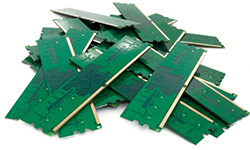Programs Hoard RAM: What Can You Do About It?

Many apps stockpile what they no longer need
Today’s complex applications tend to be flawed in a way that compromises your available memory (RAM): they are good at commandeering RAM when they need it, but terrible at letting go once the app no longer requires as much. This accumulation of trapped memory—RAM that runs away from you—often occurs when certain programs are still running but idle.
It simply isn’t necessary to allocate as much RAM to idle applications, but without being “asked” to give it back, these programs that once required a large amount will very often hoard the memory initially granted them. We all know that hoarding behavior is dysfunctional to a clutter-free, efficiently run system—whether that system is a household or a PC. Trapped memory can confuse the operating system, which is left in a state where it can’t release the previously allocated memory until the program is exited.
Memory can get trapped in two ways
Yet, many applications fail to give up that trapped RAM even then. This is sometimes due to a program’s imperative to launch faster than others the next time it is opened. Of course, if all the programs are written this way, it’s you who loses out—to hopelessly maxed out memory. Other times, a program might not release RAM even when you exit it simply due to a bug in the program. Whatever the reason, as you open, use, close, and reopen various programs, system memory can become additionally trapped.
Taken together, these two types of memory hoarding can greatly impede your system speed and efficiency over time. Yet oftentimes we want to work in many applications at once, sometimes opening and closing them frequently, sometimes leaving several open but idle on purpose. Modern multitasking demands maximum flexibility, whether we are doing a lot of tab-switching in a browser, or leaving applications unused but running for days on end to remind us of tasks we still need to return to later.
In the bigger picture, each idle task holds memory that could be put to better use—that is, given to a task you are currently performing. The result is unusable RAM that should be put to better use. Multiply that by the dozens of programs you might be running on a given day, and it can quickly become a significant drain on your resources.
A solution right when you need it
So what is the way around the problem of runaway RAM? Enter RAMJet™, an automatic, real-time tool in System Mechanic that kicks in right when your system is low on free RAM. RAMJet takes back the disjoined and trapped memory held captive by idle programs and adds it to the overall cache of available fast memory.
This powerful performance enhancer is a component of LiveBoost™ Technology, and it includes an exclusive three-tiered structure that classifies processes in terms of their need for RAM. RAMJet perceives the exact times when your system is taxed by the heaviest workloads and only performs RAM reallocation at that point. When your available RAM falls below 35% of total memory, RAMJet combs through your system looking for trapped free memory—think of it as your hoarding cleanup crew, always on the lookout for budding new hoards.
Real-time technology for today’s multitasking
What you feel is an immediate improvement in system performance. Programs launch faster, multitasking between applications goes smoother, and you experience less waiting around for your system to keep up with whatever it is you’re doing. RAMJet battles right on the front lines against system lag, where the war is waged moment to moment and is an ongoing one. Without RAMJet, in just a few minutes of heavy multitasking on your PC, you may find unnecessary hoards of system memory accumulating, fast contributing to system slowdown. RAMJet works tirelessly to fight the hoard, giving back precious RAM as you work, in real time so you don’t have to run a separate tool later, or worse—reboot.
Auto-tuning technologies in LiveBoost
RAMJet is one of the powerful performance enhancers that make up LiveBoost Technology. Get the most out of your PC with OptiCore™, granting maximum processor power in real time for the task at hand; RAMJet, for automatically enhanced system memory; AcceleWrite™, which proactively prevents hard disk fragmentation before it can even occur; and PowerSense™, which dynamically senses your resource needs and switches power settings and processor modes in real time. These features are fully automated, and enabled by default. This is responsiveness tuning that moves you beyond optimized.








